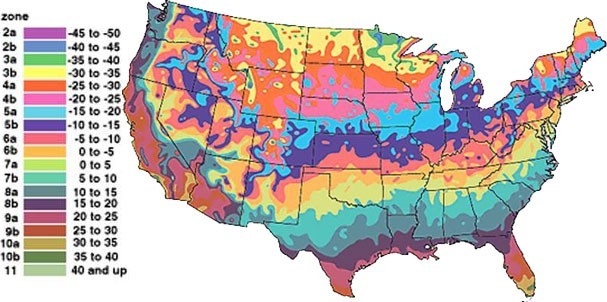
If all that gardeners ever grew were locally adapted plants, you’d have no reason to find out or concern yourself with hardiness zones. But of course, you want it all, right? You want to grow exotic goodies from distant lands or plants from allegedly similar but far-off places.
Indeed, you already do have it all: Peonies come from Asia, tulips hail from Turkey, and strawflowers are from Australia. So after your initial infatuation with a plant that’s new to you, you can ask yourself, “Is growing this in my garden possible?” Finding out the plant’s appropriate zone gives you an answer.
People commonly use hardiness-zone information for trees, shrubs, and perennial plants. Annuals don’t get rated, or just don’t count, because they live for only one growing season, anyway. Hardiness zones are all about survival from one year to the next. (And anything tender grown in a pot can always be moved inside out of the weather, thus avoiding the issue.) Just to complicate matters, different zone maps are out there, and some are better depending on where you live.
The USDA Plant Hardiness Zone Map is the most prevalent one that gardeners in North America use, but others exist. The American Horticultural Society’s Heat-Zone Map is more useful and popular for people in the Southern and Western USA, while Sunset’s Garden Climate Zones Map, though complex, serves the Western states well.
Indeed, you already do have it all: Peonies come from Asia, tulips hail from Turkey, and strawflowers are from Australia. So after your initial infatuation with a plant that’s new to you, you can ask yourself, “Is growing this in my garden possible?” Finding out the plant’s appropriate zone gives you an answer.
People commonly use hardiness-zone information for trees, shrubs, and perennial plants. Annuals don’t get rated, or just don’t count, because they live for only one growing season, anyway. Hardiness zones are all about survival from one year to the next. (And anything tender grown in a pot can always be moved inside out of the weather, thus avoiding the issue.) Just to complicate matters, different zone maps are out there, and some are better depending on where you live.
The USDA Plant Hardiness Zone Map is the most prevalent one that gardeners in North America use, but others exist. The American Horticultural Society’s Heat-Zone Map is more useful and popular for people in the Southern and Western USA, while Sunset’s Garden Climate Zones Map, though complex, serves the Western states well.

No comments:
Post a Comment